A Beautiful Garden Dug Into Submission
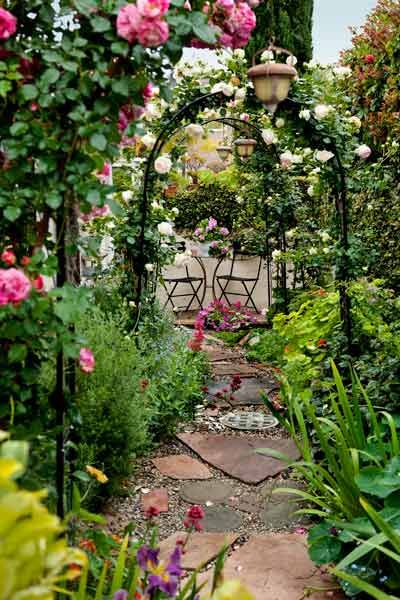
Planting a daylily seemed a simple enough task when Brigitte and Charles Christensen moved to their Southern California home. But her shovel barely made a dent in the rock-hard adobe soil. Eventually she pounded through with a posthole digger.
Fast-forward 17 years. Today the soil is soft and fluffy, and the Christensens’ quarter acre is lush with 75 kinds of roses and nearly as many types of perennials, plus trellises, fountains, a terraced vegetable garden, an estate-worthy rabbit hutch, a rock-lined fishpond, a winding brick path, and several outdoor dining areas. And it was all done on a shoestring, thanks to help from family and friends, contributions from other gardeners, and a few clever work-arounds to save money.
Shown: For a flower lover, what better place to sit could there be than at this bistro set, enjoying the view through a series of rose-covered arbors?
From Sorry to Inviting Lawn
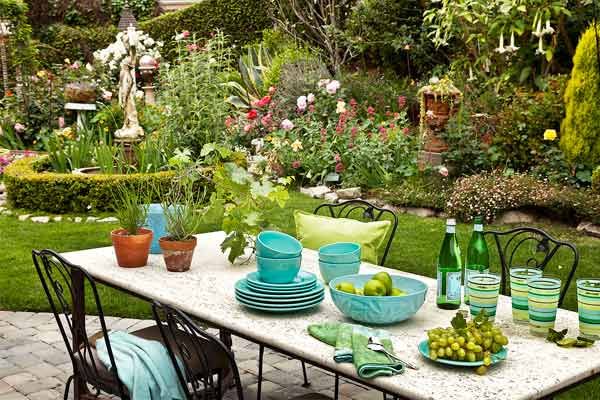
The Christensens’ first budget-conscious decision was the house itself. “We looked for the least expensive house in the very best neighborhood we could find,” Brigitte explains. They settled on a foreclosed 1970s Cape Cod-style home with stained carpets, kicked-out balusters, and a yard that consisted mostly of sorry-looking lawn and some half-dead rosebushes. But the property was in a cute town—San Clemente—and located just a quarter mile from the beach, and the house’s issues were mostly cosmetic. The large, wedge-shaped yard was full of possibilities. “To me it was a clean slate,” Brigitte says.
Shown: For entertaining, the Christensens use the dining area on this paver patio, just steps from the kitchen and overlooking the gardens.
More is More in This Garden
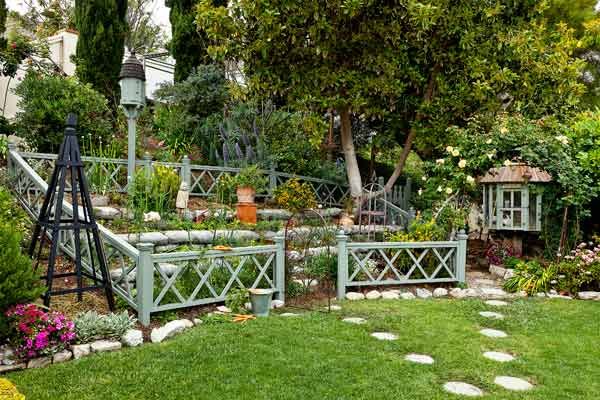
Design inspiration for the lackluster lot came not from a high-priced consultant but from garden tours and clippings from magazines. Through these, Brigitte came to realize that high-style gardens with a limited array of plants and materials don’t appeal to her nearly as much as gardens with more going on. “I love romantic gardens that have a lot of stuff,” she says, meaning yards with distinct garden rooms furnished with architectural accents and a wide range of plants. “I figure, you have a yard. A lot of people don’t. Use every bit of it.” So she set out to create the rich jumble of an English country garden, mixing cottage-style informality with formal statuary and trelliswork.
Shown: The south-facing vegetable garden is terraced into the hillside with a Hass avocado tree towering over it and Italian cypresses standing like sentinels at the back.
Concrete Bags for Terraced Rows
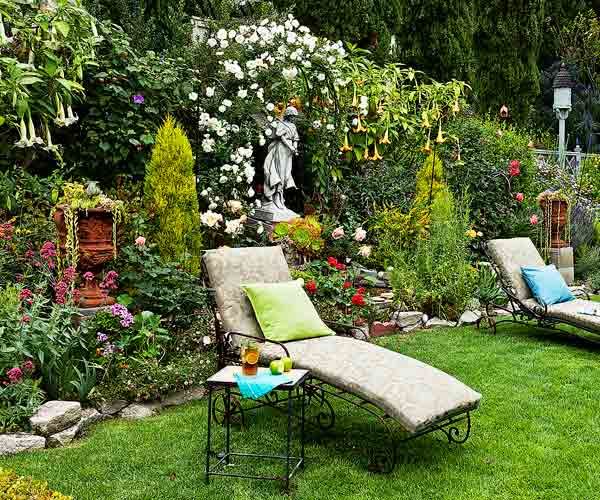
Because the couple’s budget was tight and they were doing the work themselves, they tackled the yard in sections, starting with the southwest-facing hillside in the back. To create terraces for growing vegetables, stone walls weren’t in the budget. So they substituted something Brigitte had seen on a garden tour: using bags of concrete mix to shore up the terraced rows. One section at a time, they positioned the unopened bags along the downward slope, then soaked them with a hose each day for a week. Once the concrete inside the bags was stiff, they added another row and watered that. They repeated this procedure until they had enough supports for flat planting beds. When complete, they ripped off the paper to reveal tidy rows of pillow-shaped concrete blocks. When a few pieces shifted slightly over time and one row tipped a bit, Charles simply got out a shovel and nudged the blocks back into place.
Shown: The land is flat immediately behind the house, then rises dramatically. The couple kept lawn in much of the flat area for stretching out on lounge chairs. A series of garden vignettes, each centered on an art object, borders the grassy area.
Built from The Soil Up
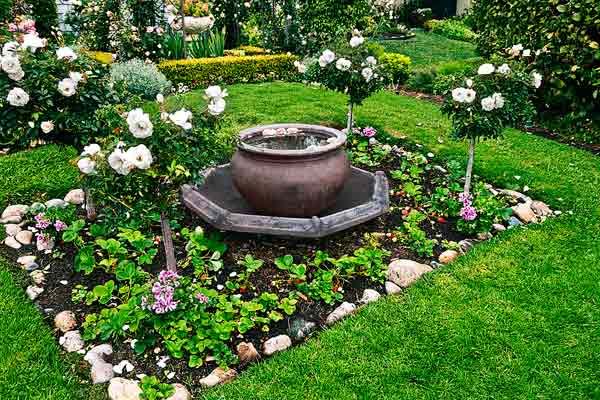
The couple lined other planting beds with chunks of discarded concrete, which they also used, combined with old bricks and flagstones, for pathway paving. Some pieces came from neighbors redoing yards and driveways, and some from the “free” section in a local newspaper. Brigitte bought pavers, too, a few at a time at home centers, driving them home in her car. To build up the soil, she used lawn clippings, hauled in composted horse manure and hay, and took advantage of free mulch available from their homeowners’ association.
Shown: Little pocket gardens dot the lawn, including one for everbearing strawberries that has ‘Iceberg’ rose standards at the four corners and ‘Lemon Rose’ geraniums shading the roses’ roots.
The Beauty of Plant Swapping
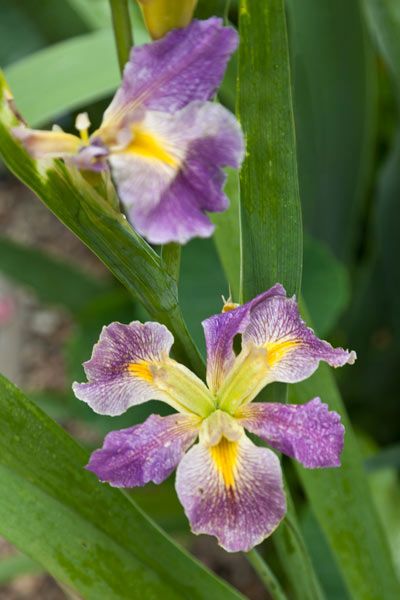
The Christensens also saved money by starting many plants from seed and buying others small, rarely in containers larger than 1 gallon. Brigitte spread the word that she was interested in swapping plants, too. Soon, friends who’d divided perennials were calling to share with her. She signed up for online gardening groups—davesgarden.com is a favorite—and began swapping plants with people she never met. A Northern California woman mailed her boysenberries, one of the edible plants the Christensens enjoy most.
Shown: Bea Grow, a locally famous gardener who died in late 2012, gave homeowner Brigitte Christensen a start of this ‘Louisiana’ iris. Brigitte has many plants given to her by other gardeners who have since passed away. The plants have turned out to be a lovely memorial; when they bloom each year, Brigitte sees the blossoms as her old friends waving hello.
Thrifty Pergola and Arbor Finds
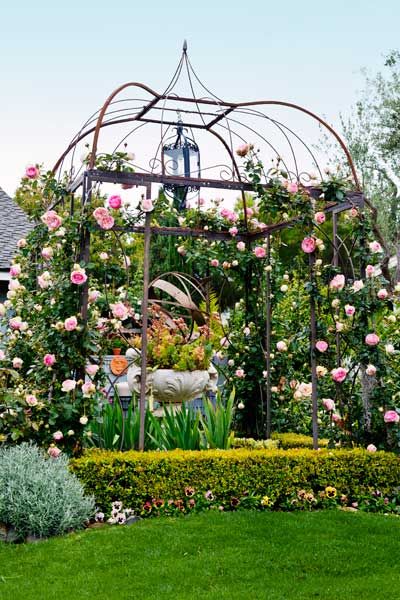
Another sprawler, the ‘Eden’ rose, grows on an iron pergola bought at a thrift store for $300. Some of the supports were rusted out, so Brigitte and Charles wired on the legs of an inexpensive canvas shade structure, creating the look of a pergola that would sell for $1,500 to $3,000. Brigitte also hauled home a few metal arbors she found at a Big Lots discount store for $15 each. “I painted them black, added rebar stakes, and tied wire around them,” she says. “When they’re covered with vines, you can’t tell.”
Shown: Pink ‘Eden’ roses climb the iron pergola that frames a knot garden of low variegated-boxwood (Buxus micro) hedges, with sword-shaped iris foliage surrounding a central urn, and a lone curry plant (Helichrysum angustifolium) at each corner.
Budget Garden Art Curation
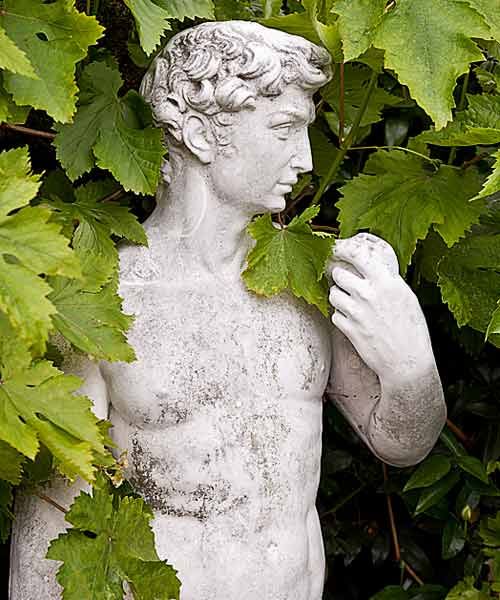
Outfitting the garden with art pieces on a budget was easy. Brigitte simply spread the word among family and friends about what she wanted for gifts. On her 50th birthday, she was walking through a nursery with her mother when they spotted a copy of Michelangelo’s David. He now stands outside Brigitte’s office window, with a modesty-preserving merlot grapevine standing in for fig leaves.
Rabbit Hutch That Gives Back
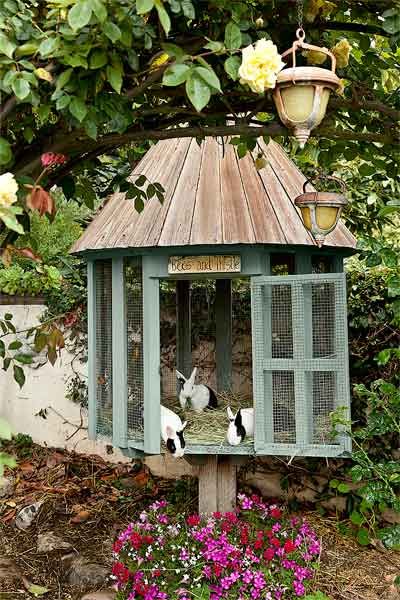
But perhaps the biggest money-saving strategy in the garden was having handy folks in the family. Charles built a handsome fence for the vegetable garden that mimics one Brigitte spotted in an article about a Victorian garden. The couple’s grown son, Kane, paints the fences, and college-student daughter Jade helps care for the bunnies. Brigitte’s late father designed and built several attention-getting features in the garden, including the rabbit hutch and a tepee trellis on which Brigitte rotates cucumbers, beans, and snap peas.
Shown: The hutch is elevated for easy cleaning; droppings get recycled to fertilize the roses.
New Garden Designing Career
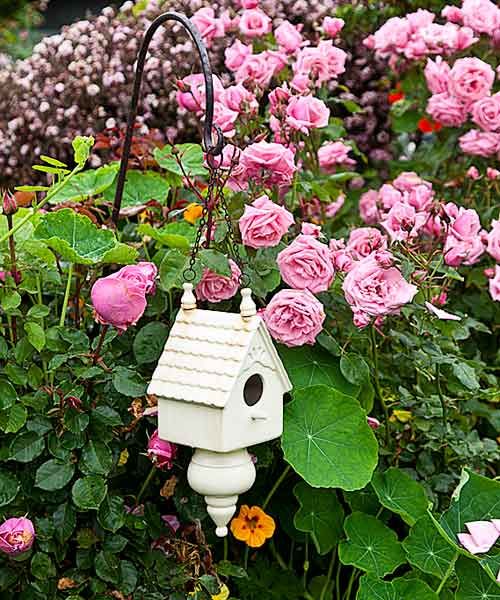
Tending her patch of earth has fed Brigitte in less tangible ways as well. After a career in the hotel industry, she decided to go back to school to become a professional garden designer. “It’s fun to transform something, especially when there is nothing there to start,” she says.”And it’s really fun if the homeowners are passionate.”
But on her own turf, Brigitte doesn’t have to guess at how much follow-up care the plants she puts in will actually receive. “Here, gardening brings me peace and passion, as well as exercise. And it’s the best psychiatrist ever.”
Entertaining on a Budget
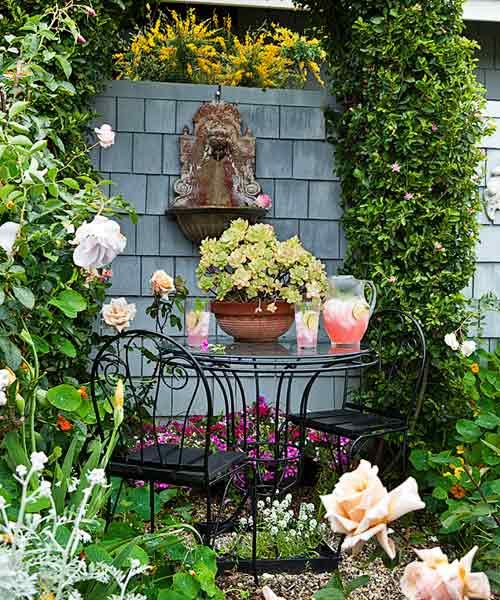
This iron bistro set, shielded from the street by a shingled privacy screen, was a thrift-store purchase; the wall fountain was an eBay find.
Concrete Bag-Based Crops
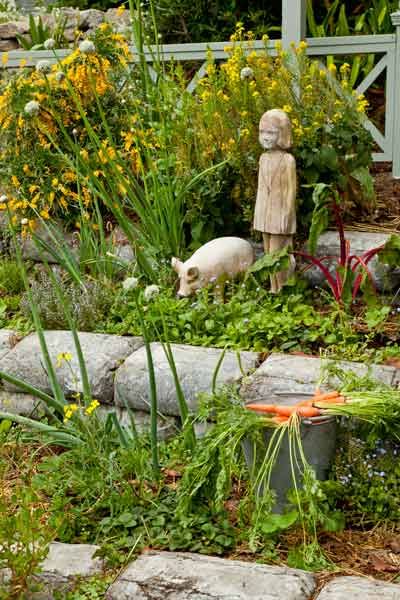
In the vegetable garden, the couple created the terraces by setting out bags of concrete mix, letting them harden, then ripping off the paper. They set the bottom row into the soil as a foundation and staggered the joints between bags on higher layers, just as if they were building with stone. Here, statues of a little girl and a piglet add a decorative touch to the crops.
Plenty of Plants to See
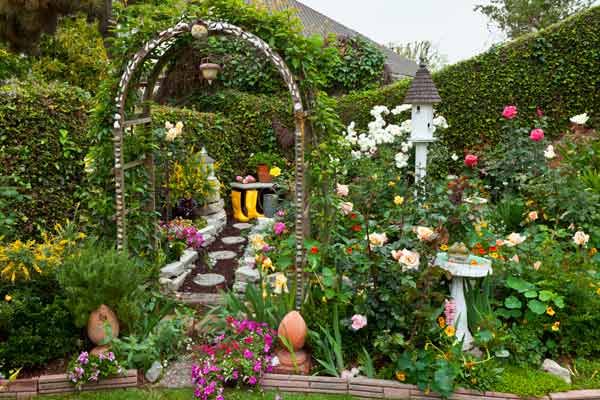
This patch of yard definitely reflects homeowner Brigitte Christensen’s love of gardens “with a lot going on.” Plants edging the lawn include ‘Tuscan Blue’ rosemary on the left, pink-and-white impatiens near the middle, and assorted nasturtiums and ‘Lime’ thyme—named for its lime-green leaves, not its taste. A fruiting pear tree is espaliered over the arbor, and behind it are raised beds edged with pieces of broken concrete. A white climbing ‘Iceberg’ rose grows behind the birdhouse; peach-colored ‘Medallion’ roses are in front. The darker pink rose is ‘Mme Isaac Pereire.’
Driveway in Disguise
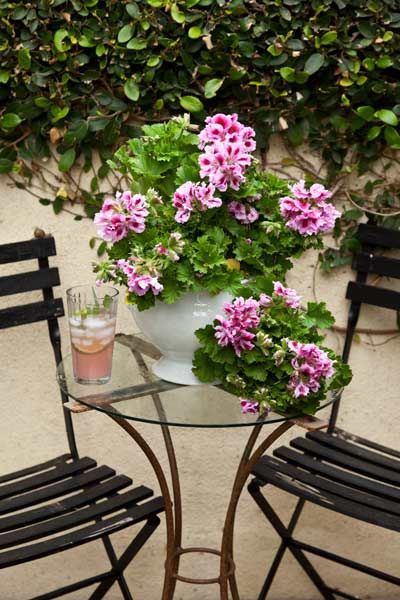
The Christensens have a three-car garage but didn’t like looking at so much driveway. So they set out a table and chairs on the paved area with a big pot of ‘Lemon Rose’ geraniums (Pelargonium graveolens). Such scented geraniums can be used to flavor lemonade: Just boil a cup of sugar and a cup of water, turn off the heat, and add about a dozen leaves. When cool, squeeze out the leaves, add a cup of lemon juice, and refrigerate. When you want lemonade, mix about 1 tablespoon of the concentrate per cup of cold water.
Pond-Loving Plants
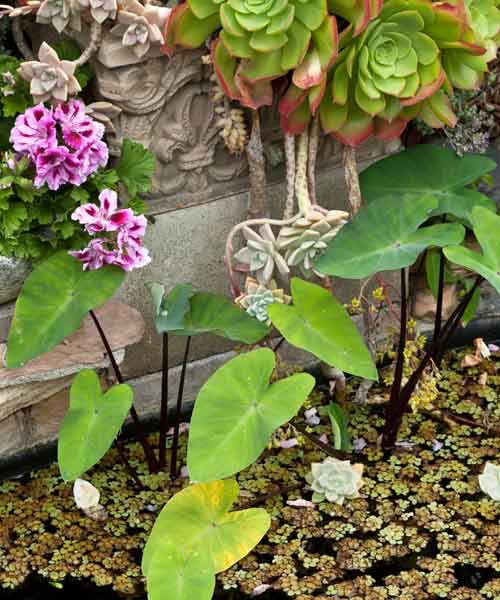
In a little pond stocked with goldfish and mosquito fish, the Christensens grow calla lilies (Zantedeschia aethiopica), whose leaves resemble elephants’ ears. The draping succulent is an aeonium (A. arboretum); the pink-and-white flowers are ‘Lemon Rose’ geraniums.
Flowering Edibles
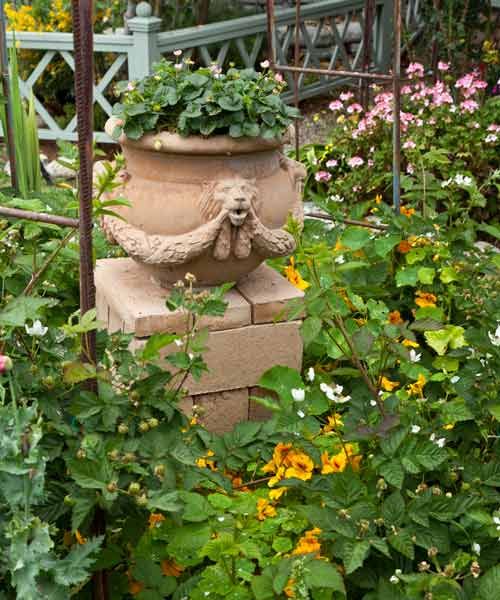
Once part of a fountain, this lion’s-head pot is now home to pink-flowering strawberries. ‘Pink Panda’ (Fragaria Comarum), one of the first varieties with this color, produces little fruit, but newer types, such as ‘Berries Galore,’ have both pink blossoms and good fruit production. Boysenberry vines and nasturtiums grow in front of the pot, and bushy ‘Maverick Star’ geraniums grow in the background.
Bargain Find, Plus Patina
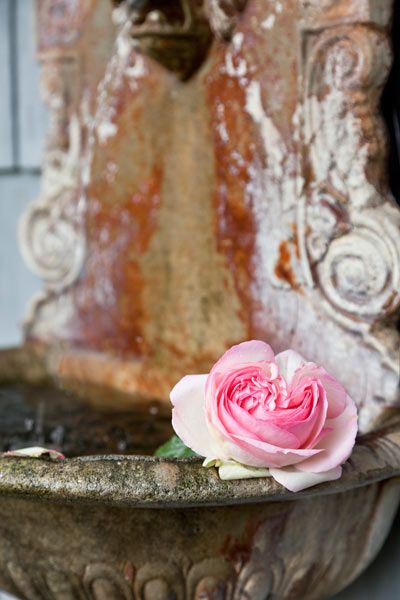
An eBay find, this cast-concrete wall fountain has developed a nice rusty and mossy patina over the years.
Defunct Light Turned Ornamentation
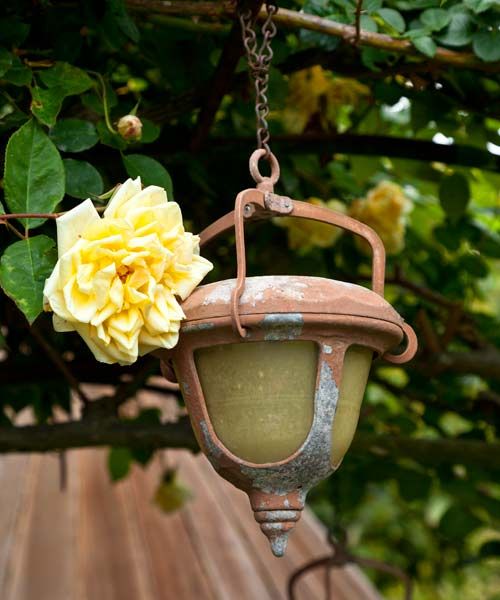
Now more form than function, this onetime solar light (it no longer works) still hangs as decoration from a metal trellis covered with the fragrant antique rose ‘Reve d’Or.’
Face with Floral Personality
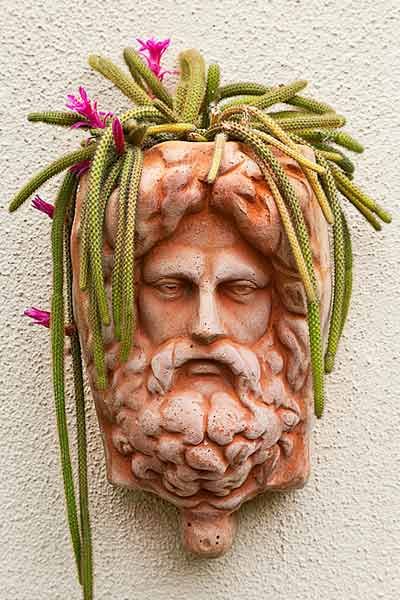
Ornaments around the gardens include a wall-hung figural planter.
Graceful Planter
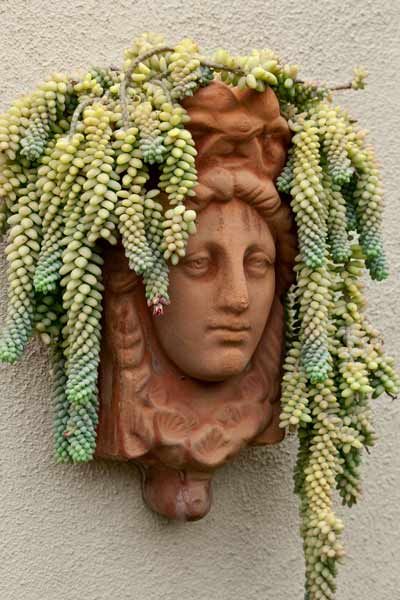
A living headdress of donkey’s-tail sedum (S. morganianum), a succulent, drapes gracefully from the top of this wall-hung figural planter.
Modern Rose with an Antique Look
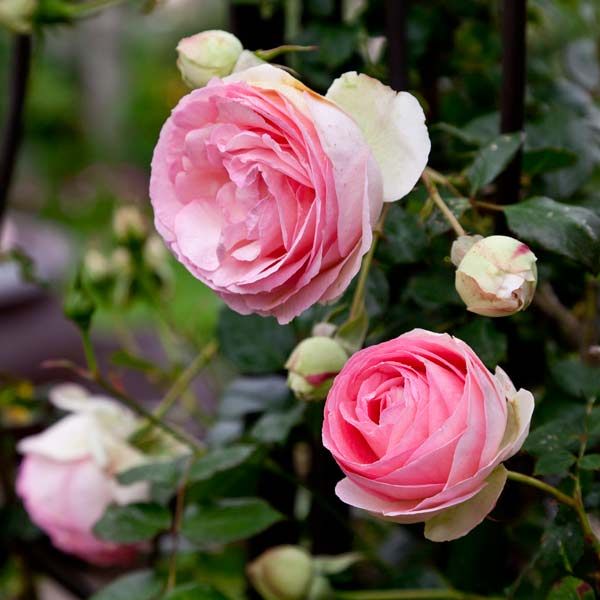
The ‘Eden’ climbing roses that grow on the pergola have the lush, fully double look typical of many antique roses. But, in fact, it’s a modern variety with enhanced disease resistance, developed in France and introduced in 1987; it’s also known as ‘Pierre de Ronsard.’
The Garden Plan
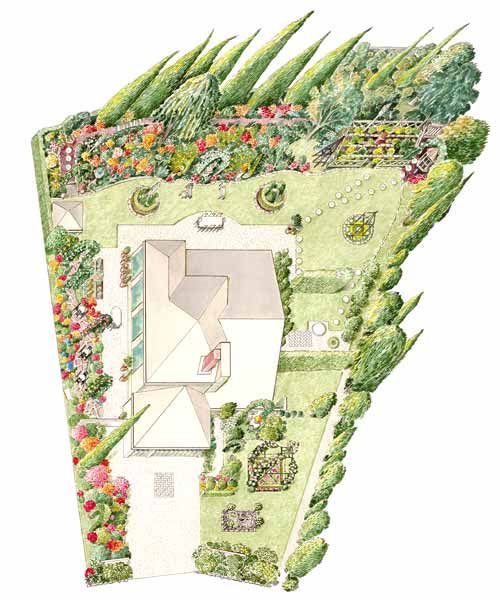
The Christensens made the most of their wedge-shaped quarter-acre lot with pocket gardens and seating areas placed throughout. The steep slope in back puts the whole hillside landscape on display when viewed from the flat lawn below.
